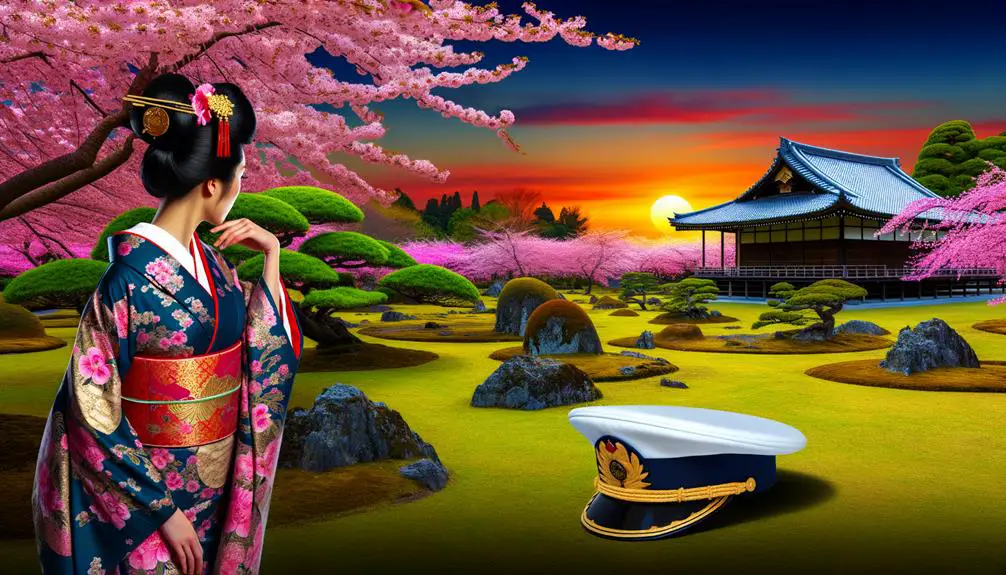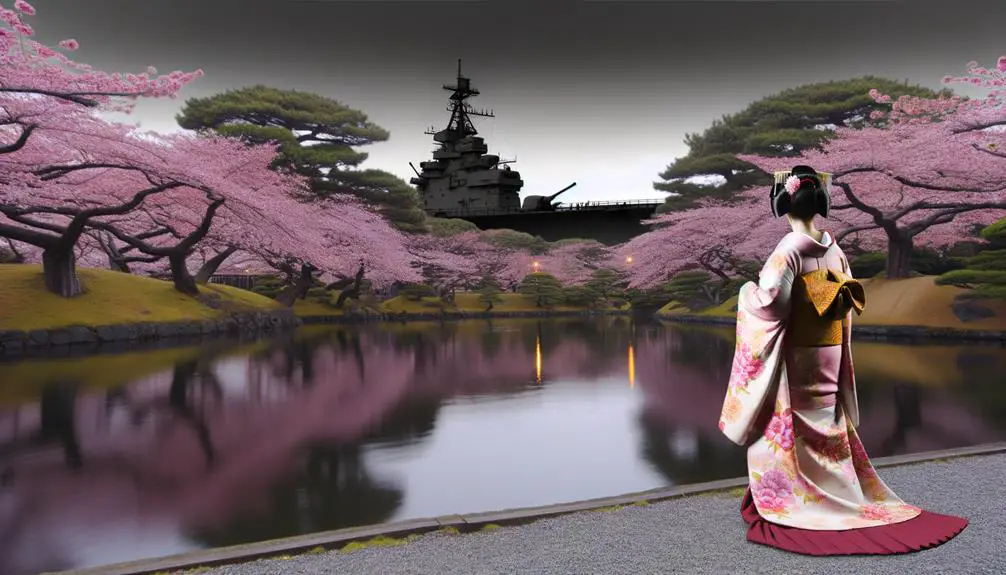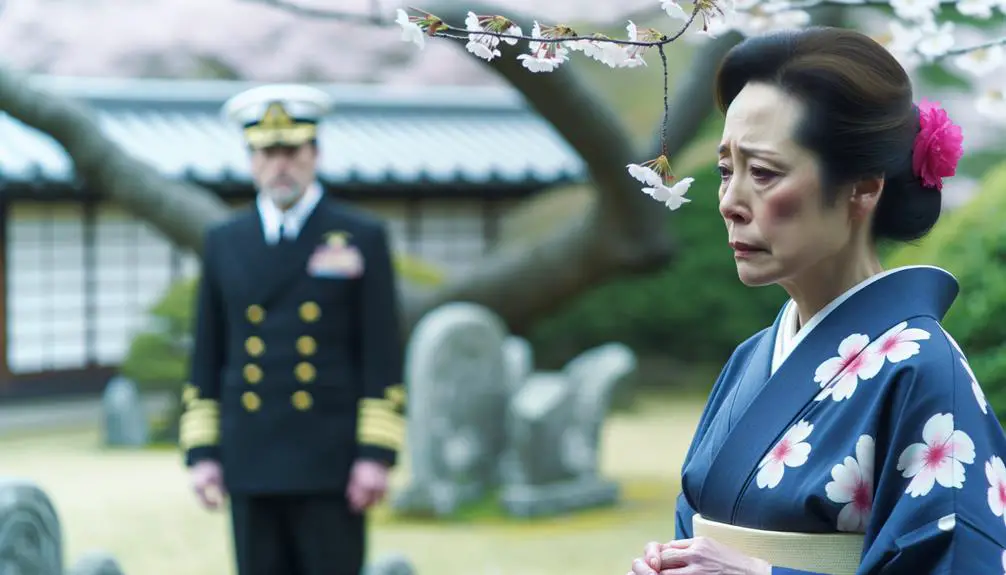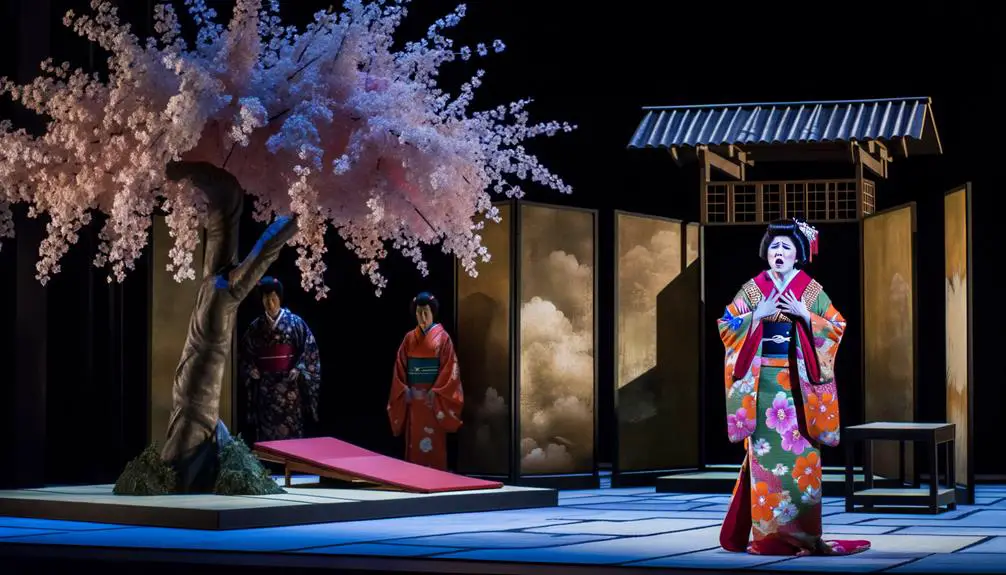What Is the Opera Plot of Madame Butterfly?
'Madame Butterfly,' composed by Giacomo Puccini, narrates the tragic fate of Cio-Cio-San, a young Japanese woman who falls in love with Lieutenant Pinkerton, an American naval officer. Their marriage, which Pinkerton perceives as temporary, becomes the foundation of Cio-Cio-San's unwavering love and hope, despite societal scorn and Pinkerton's prolonged absence.
Upon his return with an American wife, Cio-Cio-San's dreams are shattered, leading to her ultimate sacrifice. This opera masterfully intertwines themes of love, betrayal, and cultural collision, reflecting both Western imperialism and enduring human experiences.
The intricate layers reveal deeper insights into the narrative.

Key Takeaways
- Cio-Cio-San's Tragic Love: The opera centers on Cio-Cio-San's unwavering, tragic love for American Lieutenant Pinkerton.
- Cultural Clash: It explores the cultural collision between American and Japanese values, leading to devastating consequences.
- Pinkerton's Betrayal: Pinkerton's abandonment and betrayal of Cio-Cio-San highlight themes of trust and heartbreak.
- Ultimate Sacrifice: Cio-Cio-San's story culminates in her ultimate sacrifice driven by despair when Pinkerton returns with an American wife.
Origins and Background

The origins and background of 'Madame Butterfly' are deeply rooted in the cultural and historical interactions between the East and the West during the late 19th and early 20th centuries. This period saw the increasing presence of Western powers in Asia, leading to complex exchanges and often unequal relationships.
Inspired by these dynamics, Giacomo Puccini crafted an opera based on John Luther Long's short story and David Belasco's play. The narrative explores themes of love, betrayal, and cultural clash, mirroring the often troubled and exploitative nature of Western imperialism.
Puccini's score, characterized by its evocative use of pentatonic scales and Japanese motifs, reflects an attempt to musically bridge two disparate cultures, although it remains imbued with a Western perspective.
Main Characters
Central to 'Madame Butterfly' are its complex characters, each embodying distinct cultural and emotional dimensions that drive the opera's poignant narrative.
The protagonist, Cio-Cio-San, also known as Butterfly, is a young Japanese geisha whose unwavering love and tragic naivety form the emotional core of the opera.
Lieutenant Pinkerton, an American naval officer, represents both romantic allure and cultural insensitivity, his actions precipitating Butterfly's ultimate despair.
Sharpless, the American consul, serves as a voice of reason, his empathetic nature contrasting sharply with Pinkerton's recklessness.
Suzuki, Butterfly's loyal maid, provides steadfast support, underscoring themes of fidelity and cultural conflict.
Together, these characters create a rich tapestry of intertwined fates that underscore the opera's exploration of love, betrayal, and cultural collision.
Plot Summary

How does 'Madame Butterfly' weave its tragic narrative?
The opera, composed by Giacomo Puccini, tells the poignant tale of Cio-Cio-San, a young Japanese geisha, and her ill-fated marriage to American naval officer, Lieutenant Pinkerton.
Pinkerton, viewing the marriage as a temporary arrangement, leaves for America, promising to return.
Cio-Cio-San, deeply in love and hopeful, waits for three years, enduring societal scorn.
Upon Pinkerton's return, now with an American wife, Cio-Cio-San's world shatters.
The plot crescendos in her ultimate sacrifice, driven by despair and unrequited love.
Through its masterful orchestration and emotional depth, 'Madame Butterfly' explores the devastating consequences of cultural clash and broken promises, leaving an indelible impression on the audience.
Major Themes
'Madame Butterfly' poignantly explores themes of love, betrayal, and cultural collision, weaving them into a narrative that resonates with profound emotional intensity. These themes are meticulously interlaced, reflecting universal human experiences while highlighting specific cultural contexts.
- Love and Sacrifice: The opera investigates the depths of Cio-Cio-San's unconditional love and the sacrifices she makes, embodying the tragic beauty of devoted love.
- Betrayal and Abandonment: Pinkerton's betrayal underscores the devastating impact of broken promises, capturing the fragility of trust in human relationships.
- Cultural Collision: The narrative starkly contrasts American and Japanese values, illuminating the complexities and often painful consequences of cultural misunderstandings and imperialism.
Each theme is masterfully rendered, contributing to the opera's enduring relevance and emotional power.
Cultural Impact

Examining the cultural impact of ‘Madame Butterfly’ reveals its profound influence on both Western and Eastern artistic expressions, as well as its role in shaping perceptions of cross-cultural relationships. Puccini’s opera not only inspired countless adaptations in literature, theater, and film but also sparked discussions about representation and Orientalism in Western art. Its tragic narrative and poignant music continue to resonate with audiences, prompting deeper inquiries into cultural exchange and power dynamics. Interestingly, some might even ask, why are they called butterflies, drawing symbolic connections between the opera’s themes of fragility, transformation, and fleeting beauty.
This opera, premiering in 1904, became a pivotal work in introducing Western audiences to Japanese culture, albeit through a lens that has sparked considerable debate over its authenticity and representation.
Its themes of love, betrayal, and cultural clash have inspired numerous adaptations, including films, ballets, and reinterpretations in various media.
In Japan, the opera has been both criticized for perpetuating stereotypes and appreciated for its musical artistry.
Globally, 'Madame Butterfly' continues to serve as a catalyst for discussions on the complexities of cultural appropriation and intercultural dialogue.
Conclusion
Madame Butterfly serves as a poignant exploration of cross-cultural encounters, tragic love, and the devastating consequences of imperialism.
The opera's resonance is akin to a delicate butterfly ensnared in a web of misunderstanding and exploitation, illustrating the fragility of human connections in the face of power asymmetries.
Just as a butterfly's wings can create far-reaching ripples, the opera's themes continue to provoke thought and discourse, underscoring its enduring cultural and artistic significance.






